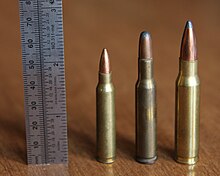.25 Remington
| .25 Remington | ||||||||||||||||||||
|---|---|---|---|---|---|---|---|---|---|---|---|---|---|---|---|---|---|---|---|---|
 | ||||||||||||||||||||
| Type | Rifle | |||||||||||||||||||
| Place of origin | United States | |||||||||||||||||||
| Production history | ||||||||||||||||||||
| Designer | Remington Arms | |||||||||||||||||||
| Specifications | ||||||||||||||||||||
| Case type | rimless | |||||||||||||||||||
| Bullet diameter | 0.2575 in (6.54 mm) | |||||||||||||||||||
| Neck diameter | 0.286 in (7.3 mm) | |||||||||||||||||||
| Shoulder diameter | 0.396 in (10.1 mm) | |||||||||||||||||||
| Base diameter | 0.417 in (10.6 mm) | |||||||||||||||||||
| Rim diameter | 0.419 in (10.6 mm) | |||||||||||||||||||
| Case length | 2.05 in (52 mm) | |||||||||||||||||||
| Overall length | 2.53 in (64 mm) | |||||||||||||||||||
| Rifling twist | 1 turn in 8" or 1 turn in 10" | |||||||||||||||||||
| Maximum pressure | 34000 to 36000 PSI | |||||||||||||||||||
| Ballistic performance | ||||||||||||||||||||
| ||||||||||||||||||||
| Test barrel length: 22 Source(s): Whelen, Townsend. The American Rifle. The Century Co: 1918, p. 230-1. | ||||||||||||||||||||
The .25 Remington (also known as the .25 Remington Auto-Loading) is an American rifle cartridge. A rimless, smokeless powder design, this cartridge was considered to be very accurate by period firearm experts and suitable for game up to deer and black bear.[1]
The .25 Remington cartridge dates to 1906 and its introduction by Remington in the Model 8 rifle. Other rifles chambered for the .25 Remington include the Remington 14 slide-action, Remington 30 bolt action, Stevens 425 lever-action, and Standard Arms rifles. Due to their similar dimensions, the .25 Remington, .30 Remington, and .32 Remington together were known as the Remington Rimless cartridge series.[2] Firearm manufacturers generally offered all three of these cartridges as chamberings in a rifle model rather than just one of the series. The series was competitive with Winchester Repeating Arms Company's contemporary lever action offerings: .25-35 Winchester, .30-30, and .32 Winchester Special.
The .25 Remington case was shortened and necked down to .22 caliber to form Lysle Kilbourn's wildcat .22 Kilbourn Magnum Junior and the rimless version of Leslie Lindahl's wildcat .22 Chucker.[3]
Harvey Donaldson also used the .25 Remington case in early experiments that would eventually lead to the creation of the .219 Donaldson Wasp. Donaldson later switched his experimentation to Winchester .219 Zipper brass after the launch of that cartridge in 1937.
The bore diameter of the .25 Remington is .250 inches (6.35 mm) making it a ".25"/6.35 mm caliber", not to be confused with the more well known 6.5 mm bore caliber which uses 6.7 mm/.264" bullets.
See also
References
- ^ Whelen, Townsend (1918). The American Rifle. The Century Co. pp. 230–232.
- ^ Stebbins, Henry M. (1958). Rifles - A Modern Encyclopedia. Stackpole Co. p. 182.
- ^ Landis, Charles S. (1946). Twenty-Two Caliber Varmint Rifles. Small Arms Technical Publishing Company. pp. 106, 118.
